I hope everyone had a great holiday and New Year.
I saw my friends were doing various traditions according to their country of origin. Some ate grapes at midnight, reminding me of the new year I celebrated in Barcelona–12 grapes, one with each bell ring at midnight of the New Year’s Eve. Some were eating osechi–obviously this is the Japanese tradition, packed beautifully in a box–or maybe just some simple ozoni, rice cake soup. I don’t need to mention the champagne with the countdown, right?
I don’t actually know what the Thai New Year tradition is!…haha…(No wonder why I’m an expat.) I don’t know if we have anything in particular to eat on New Year’s Eve, but we do celebrate the new year like the Americans celebrate Christmas. The family gets together, we exchange gifts, we have fireworks, we exchange cards…etc.
Let me tell you how my New Year’s Eve and New Year day went in Thailand. New Year Eve is a national holiday, so we usually have two free days to be home. My dad and mom had to plan which day they would go visit relatives and which day they would stay home so others could come visit us.
Our road tour started with packing the trunk of the car with gifts as neatly as possible because we would have to go to half a dozen of spots or more. The gifts usually overflowed to my seat, so my sister and I would sit as close to the car doors as possible to leave space for the gifts in the middle.
We got to the oldest uncle’s house, handed out the gifts and received some too. I kinda preferred the gifts in the little envelope, just like the red envelope during the Chinese New Year. (No, this whole process wasn’t going to be repeated during the Chinese New Year. Our families, though half-Chinese, lost that heritage long before my dad was even born). These precious envelopes usually came from uncles; aunties were into gifts more than money. Uncles didn’t want to bother wrapping presents.
We would sit and talk for a bit at each house, then move to the next. Remember, we only had about 8-10 hours, so we couldn’t really hang out all day! If we arrived at some house during lunchtime, then we would eat with them and might spend a little more time there. (You can’t just eat and run, you know, bad manners). The foods was usually just typical, whatever they felt like eating that day, nothing special. We repeated the process at the next house until we gave away all the gifts and packed all the gifts we received back in the trunk. At the end, our car was normally as full as when we started.
Then we went home. We picked up some take-out food so we could give the cook a night off, too. If we had some fireworks left over from the Loy-Kra-Tong (late November), then we would shoot those off, then have dinner and…Ta,Ta, Taaaa…the most important gifts of the year time: the gifts from parents! No, they don’t need to disguise themselves as Santa or any other god. We’re Buddhists, we can’t lie. 😉
Near the end of New Year’s Eve night would be the time that my parents would exchange gifts and give some more to us. My dad was a very typical man. His gift to my mother could only go two ways—purse or watch. Simple, wasn’t it? If it was a big box, definitely a purse. Small box, a watch. No need to guess any further. Then our gifts were the exciting ones, just like American kids during Christmas. Our parents usually had a pretty good idea what we wanted, but to give them to us or not needed some executive decision.
We don’t do a countdown, or kiss at midnight (we don’t actually kiss or hug as part of our culture), or wait to hear some bell ring or ball drop or eat anything special. We just went to bed, no cookie dishes for anyone, but we would have to get up early on New Year’s Day to give food to the monks first thing in the morning.
Then we stay home and several guests come over to give our parents some New Year’s baskets filled with goodies, and we might get some more gifts. Some were our parents younger relatives (we already visited the older ones the day before) and some are people who worked for my parents—more for my dad than my mom—but both of them were very very strict with their “No gift” policy. They didn’t allow any current employees to give them anything but good hard work. They said a small gift can open the door to corruption, so the no-gift policy was the only way.
The ones that they allowed to give them some nominal gift would be ex-employees, or some employees who already transferred out of their jurisdiction, some younger friends, family friends and younger relatives. We liked them too. Even though their gift baskets were not our focus, their kids that they brought along were our long-awaited playmates.
On this occasion we would be the ones providing them with a meal, lunch, snack, or tea time. These also would not be anything special. Anything that was convenient to prepare and eat, and also can sit out until people arrive and still be good for the next set of guests, too.
The first menu that came to my head when I thought about the New Year all-day meal is the Chinese-style hot pot that the Thai would call “Suki”, short for sukiyaki, the Japanese hot pot.
If you don’t know what “Hot Pot” is, you are so far behind, like a thousand years behind. You need to try it at least once. It is a steamboat cooking right on the table top, and everyone participates in the cooking process. The hot pot usually has a steaming hot soup continuously cooking in a specifically designed electric pot in the middle of the table. There will be many fresh ingredients such as sliced raw meat, seafood, dumplings, vegetables, mushrooms, noodles and sauce.
The whole family would sit around the table and pick the pieces of fresh raw food they wanted and add them to the pot, wait for them to be cooked, then scoop the food up into their bowl, add some broth and sauce, and eat. They would continue to do that until they were full. This is the ideal situation in a civilized family at a hot pot dinner.
The real world is this: The pot of soup in the middle is the battleground. The utensils used — are a ladle to share among the solders, a little sieve with a long handle, a pair of chopsticks and a spoon are your personal weapons (the spoon you eat with are not suppose to go in the pot, remember the Thai Etiquette). The sieve is your bunker, the chopsticks are the necessity battle weapon that you use to wag the other chopsticks away from your piece of foods that you claimed yours but can also act as an underground unit that sneak in while the enemy isn’t looking and steal their foods.
Once you drop food into your little sieve, you protect it with your life, while never ignoring other people sieves. You need to look if their piece of meat is cooking ahead of yours or behind it. Their piece might finish before yours. In that case, when the owner of the sieve blinks, you can actually steal it. “What?” (usually you don’t speak with a mouth full of food but to protect your honor, you can)…”It’s in the pot…any problem? Well, in that case, you can have my piece of shrimp here. You only have to wait a few more minutes.”…haha…get the idea?
Don’t forget to watch out and fight for the piece of food in your own sieve while you’re stealing others. Try not to drop food outside of your sieve, too. I don’t need to tell you why, do I? The vegetables are not fought over. We break them in pieces and drop them in the pot, and anyone can scoop them up and there will be more to come. I know the meat and dumplings are also unlimited, but they take time to cook–too long! 😉
Hot pot is an ancient tradition of the Chinese, starting way back in Mongolian time, even before the Kingdom of Siam was even born, over 1,000 years ago. Many tribes in China had adopted the tradition and developed their own dipping sauce and their own soups. I can’t even keep track on how many types of hot pot there are nowadays.
The two most known and most popular styles of suki in Thailand are Hainanese style and Cantonese style. The biggest difference between the two is the dipping sauce. The Hainanese style has fermented tofu and pickled garlic as ingredients, and also the type of meat that goes in the pot will be more land animals than seafood. I will write about this style later.
The most familiar style to the Thais, offered in hundreds of restaurants all over the country under a few chains, MK, Coca, Canton and the weirdest name, Texas Suki, all selling suki that was originally Cantonese style, and now I think we own it. We successfully fooled the original owner by using the Japanese name “Suki”. The Japanese saw the dish and wouldn’t dare claim the mess we made “sukiyaki”. The Chinese saw the Japanese name and wouldn’t even take a look at the dish; win-win for the Thais!
Haha…I’m just joking. The Thai didn’t mean to disguise anything. The folktales said when the first suki restaurant opened in Thailand (way before I was even born, just so you know how loooong ago it was) under the name “Coca”, it was about the same time that the song “Sukiyaki” by Kyu Sakamoto became so popular. (If you want to know more about this song, wikipedia has the whole history here)
So the owner of the Chinese hot pot shop, Coca, started to advertise the restaurant as Coca Suki, because it not only resembled the Japanese sukiyaki, but you got a song to go with it. Oh…oh, don’t ask me are how are these two issues related…someone else already stole your meatball from your sieve!
Back in the day, before the electric hot pot had entered the scene of suki in Thailand, most suki restaurants used a charcoal steamboat that you had to add real hot charcoal into the funnel in the middle of the pot. My memory of it is not quite pleasant because I had to keep moving pieces of food around the donut-shaped pot. Then a fire at the famous suki restaurant moved the charcoal steamboat out of use, and the electrical steamboat replaced it.
If you visit Thailand and watch the TV on the plane, you might see the “MK Suki Restaurant” ad right before landing. That’s one of the most well-known suki restaurants in Thailand. They were the first to use the electrical steamboat, and have expanded their chain rapidly. They almost wiped out the old brands like Coca or Canton, but Coca has recently made a come back. I’m glad.
Suki is a very healthy meal, unless of course you overeat! As you sit down (maybe after a long wait), the waitress hands you a menu. Then you pick what you want to eat in your suki—meat, seafood, vegetables and noodles—then the order would arrive —-each in its own separate plates—-. Then the games begin.
The first time I took my husband to a suki restaurant, he didn’t eat until we were half way through because he thought the pot in the middle of the table was filled with hot oil! I have no idea why he thought so. There is no smell of oil in the place and the whole restaurant was filled with tables with clouds of steam. Until I told him that the liquid in the pot was soup and not oil, then he relaxed and enjoyed it.
The most important part of a suki meal is the dipping sauce, which is added to your bowl after you’ve taken and stolen your cooked ingredients and broth.
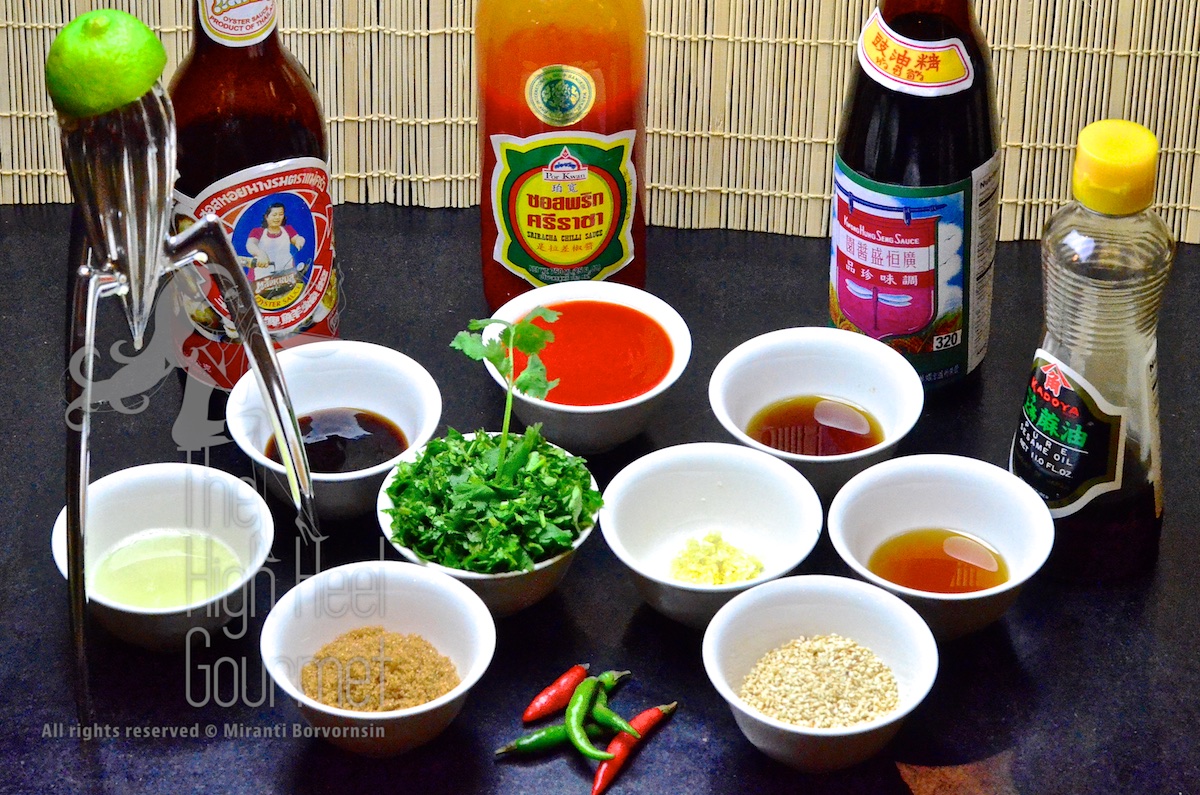
From left spider clockwise; Lime juice, Oyster sauce, Real Sriracha sauce or at least chili sauce made in Thailand, Light soy sauce, sesame oil, roasted white sesame seeds, bird eyes chili (I forgot to mention these. You can chopped them and mix them in the sauce or add them to your bowl if you like it HOT…), sugar, Chopped cilantro, chopped garlic.
Ingredients (for 2)
Sriracha sauce 1/4 cup, preferably NOT the Huy Fong brand with the one chicken logo in the front*
Oyster sauce 2 tablespoons
Light soy sauce 3 tablespoons
Lime juice 1/4 cup + 1 tablespoon
(optional) Sugar 3-4 tablespoons I used brown sugar
Chopped cilantro, as much as you prefer. I used a lot, like 1/2 cup because I like it that way, but 2-4 tablespoons are about right.
Chopped garlic 1 teaspoon
Sesame oil 1 tablespoon
Roasted white sesame seeds, also as much as you like. I used 1/4 cup, which is a lot too. Normally at the restaurants they probably use only 1-2 tablespoons
Method
One step; just mix them all together.
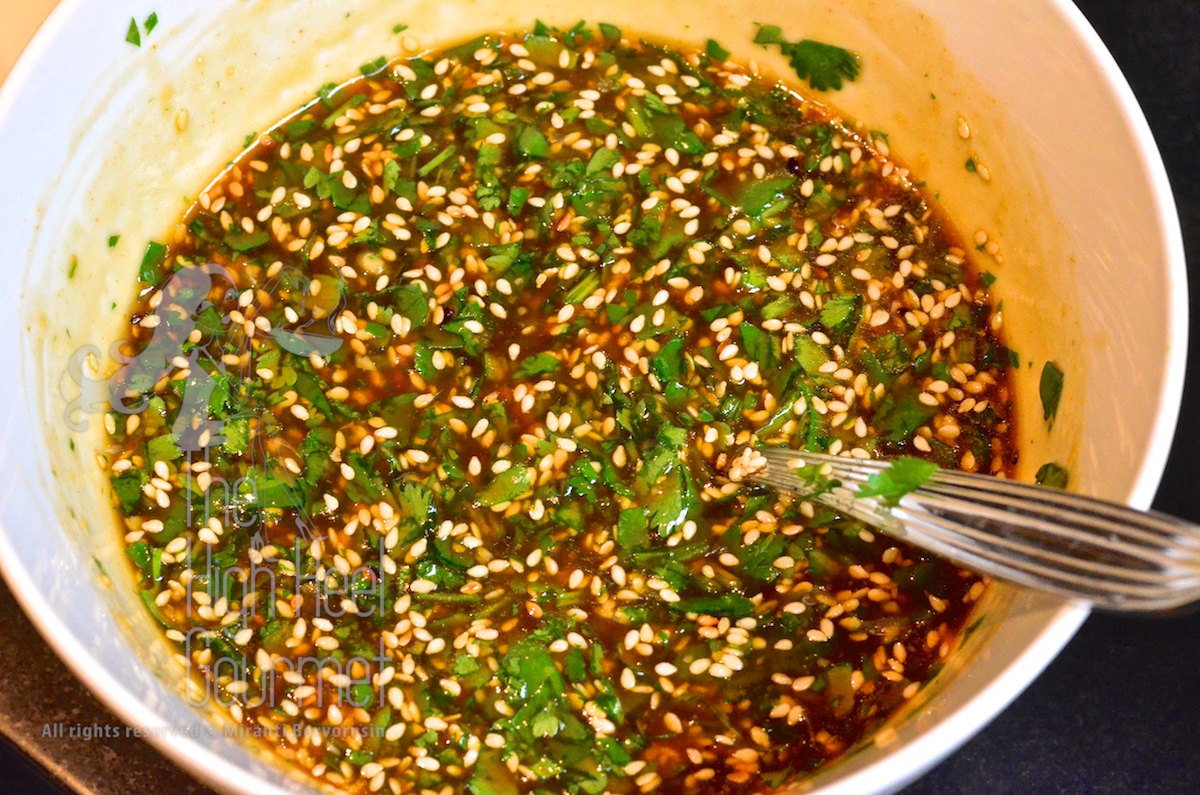
Well, I have to tell you that my version has A LOT of chopped cilantro and sesame seeds. Yours might not need this much.
Note
The proportion of these ingredients is based on my own taste. You might want to adjust the taste to your liking.
If you have left over just boil the sauce over the stove until it bubble then you store it in the clean jar, It keeps for a long time but you might need to add cilantro and chopped garlic again when you want to use it.
Once you have the dipping sauce, the rest is up to you. What do you want to put in the broth? Anything goes.
So, how to make the soup?
Ingredients
Water about 8 cups
Sliced daikon root 6-8 slices
Garlic 2-3 cloves
Chicken backs and pork bones, if you have them. If not, Knorr seasoning or nothing at all is okay.
Method
Boil them together on the stove until the daikon roots slices look clear, then you will add this broth to the steamboat and keep it boiling.
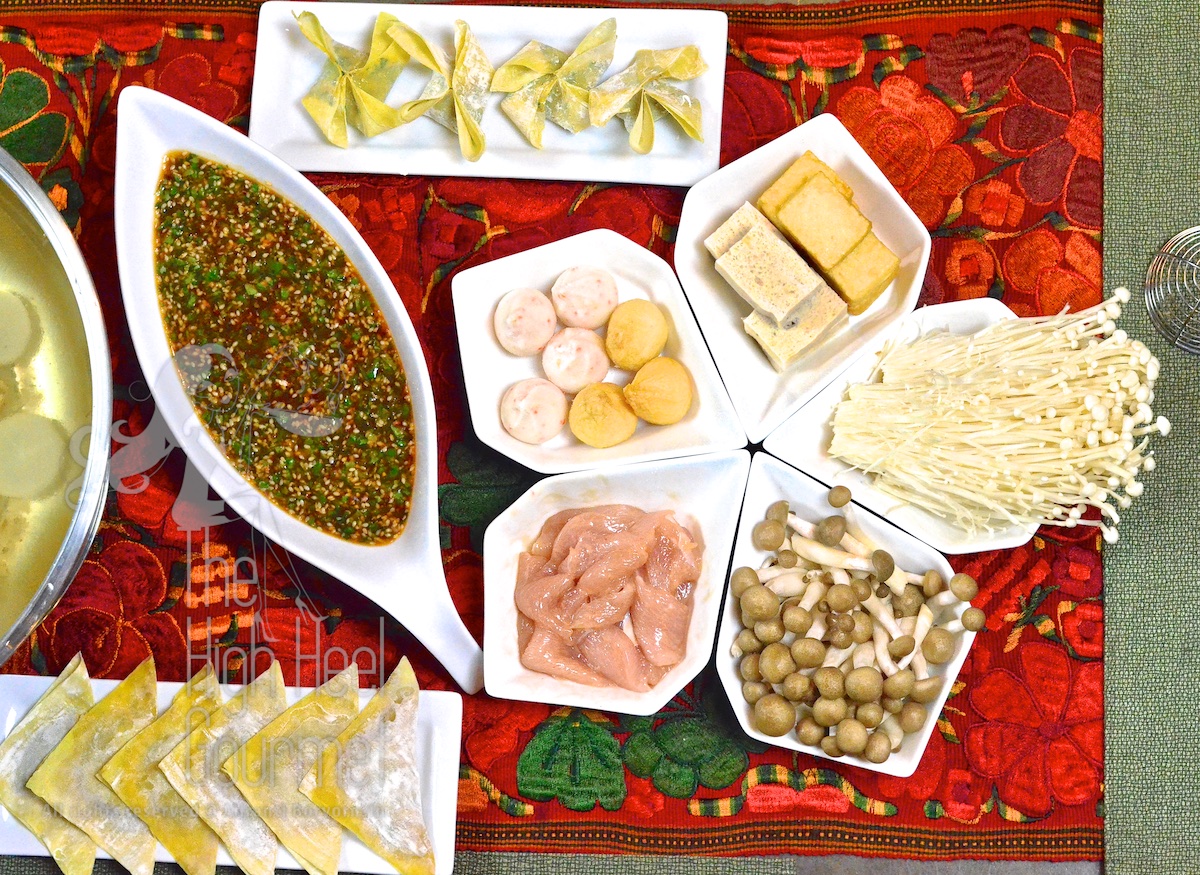
From top, beef wonton
Left is the dipping sauce. In the five dishes clockwise from top: Tofu and fish-tofu fried balls (in squares), Enoki mushrooms, Shimeji mushroom, chicken, fish balls filled with fish roe (the brown ones are the same thing fried.) Bottom are the shrimp and pork dumplings.
A few tips about the meat and vegetables to be put in hot pot.
1) Use the freshest ingredients you can find.
2) The vegetables should be cut right before you put them in. Do not prepare them way beforehand.
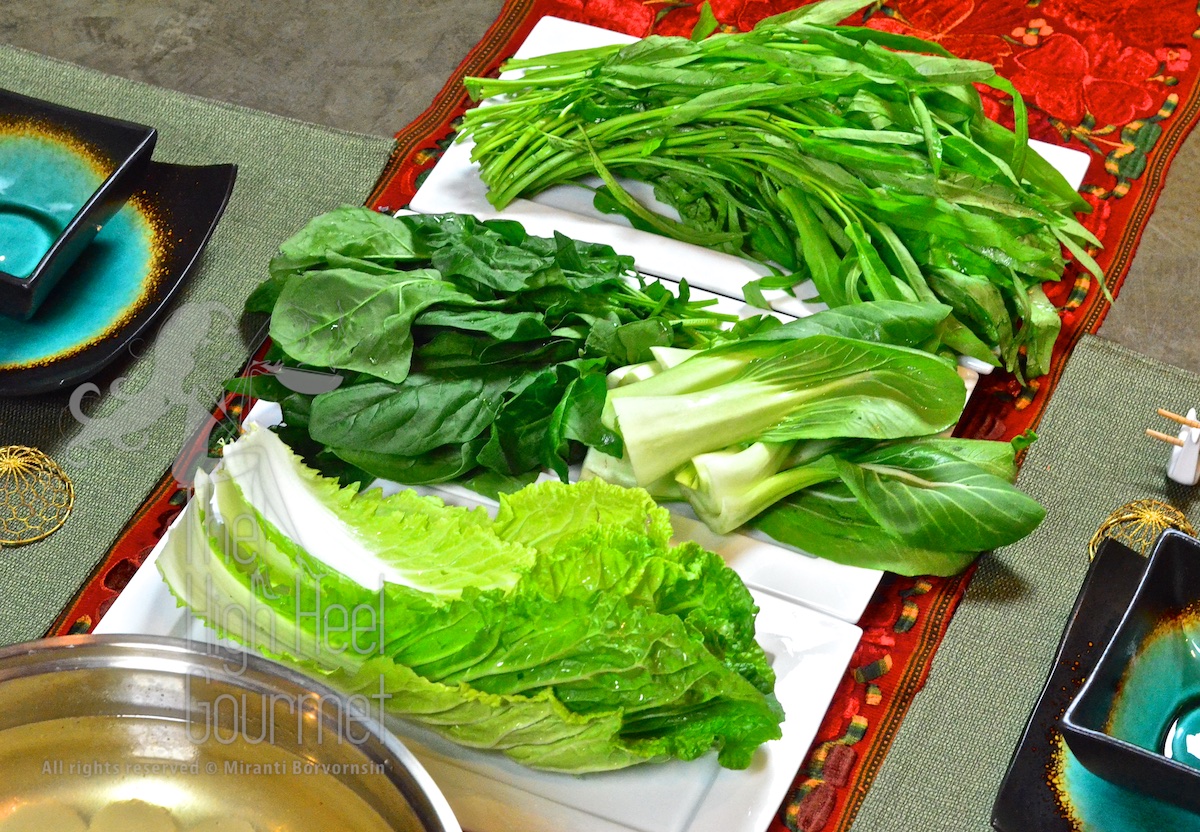
From top: Ong Choy or Chinese watercress or morning glory (Pak-Boong), Spinach and Bok Choy , Napa cabbage
3) I usually marinate the meat with sesame oil and light soy sauce.
4) You can buy a lot of meatballs, shrimp balls, and fish balls at the Asian market. They either come frozen in a package, or you can buy them freshly made from the same place you get fresh fish.
5) I made my own dumplings, too. Usually just shrimp dumplings, because that’s my favorite. I also marinate the shrimp with sesame oil and soy sauce. Sometimes I add a little ground pork in, and wrap them together.
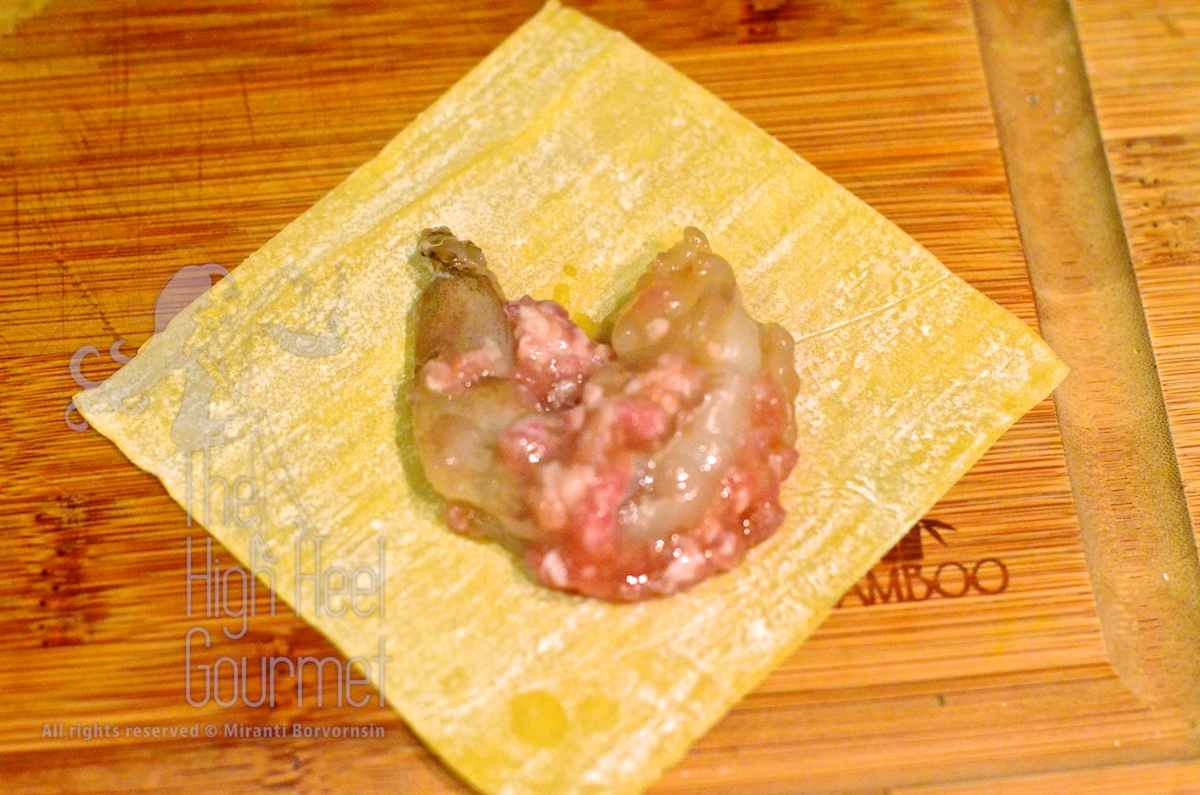
I didn’t mean to blur it but this is the only picture. All I did was just fold the wonton wrapper over the shrimp and press around the filling. Not complicated.
A few tips about cooking in the steamboat.
1) Add vegetables first and wait until the water is boiling again, then add the meats.
2) Only take the meat out when it floats in water, meaning that it is fully cooked.
3) If you have to refill the soup, wait until it is back to boiling again before you add more meats.
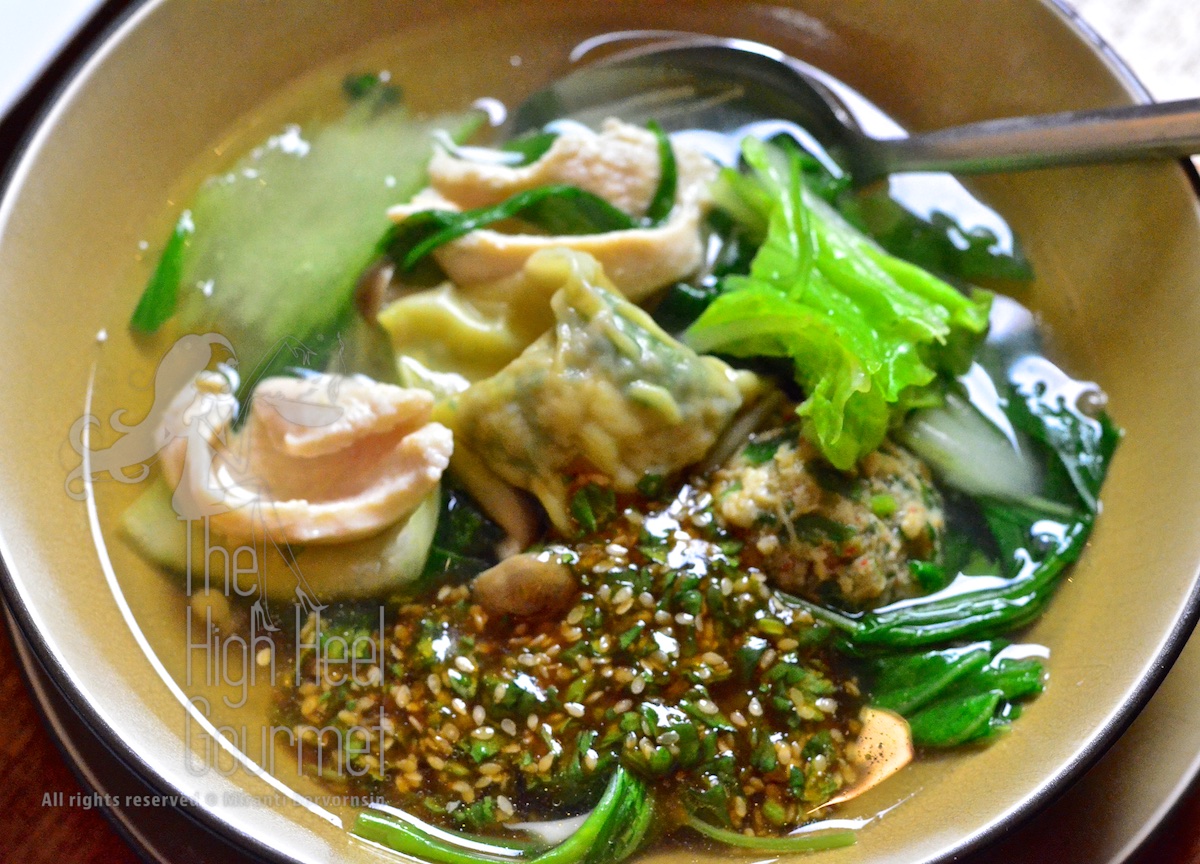
This is your winning prize. You add the soup and the sauce then you can enjoy. NO ONE is allowed to steal from your bowl. This was my husband’s bowl. He likes to use the bigger but shallower bowl so the soup cools off faster. (I can feed him Chinese but I can’t turn him Chinese enough to eat extremely hot food)
Let’s the game begin. I hope you win 🙂 And the Thai eating etiquette I wrote about last year doesn’t apply. Well, not to me. I don’t offer my pieces of meat to anyone. You have your own sieve and a pair of chopsticks, same as me. (Well may be I’m a little quicker from experience, that’s all. You only need to watch the shrimp dumplings, though. I don’t eat other the other stuff.)
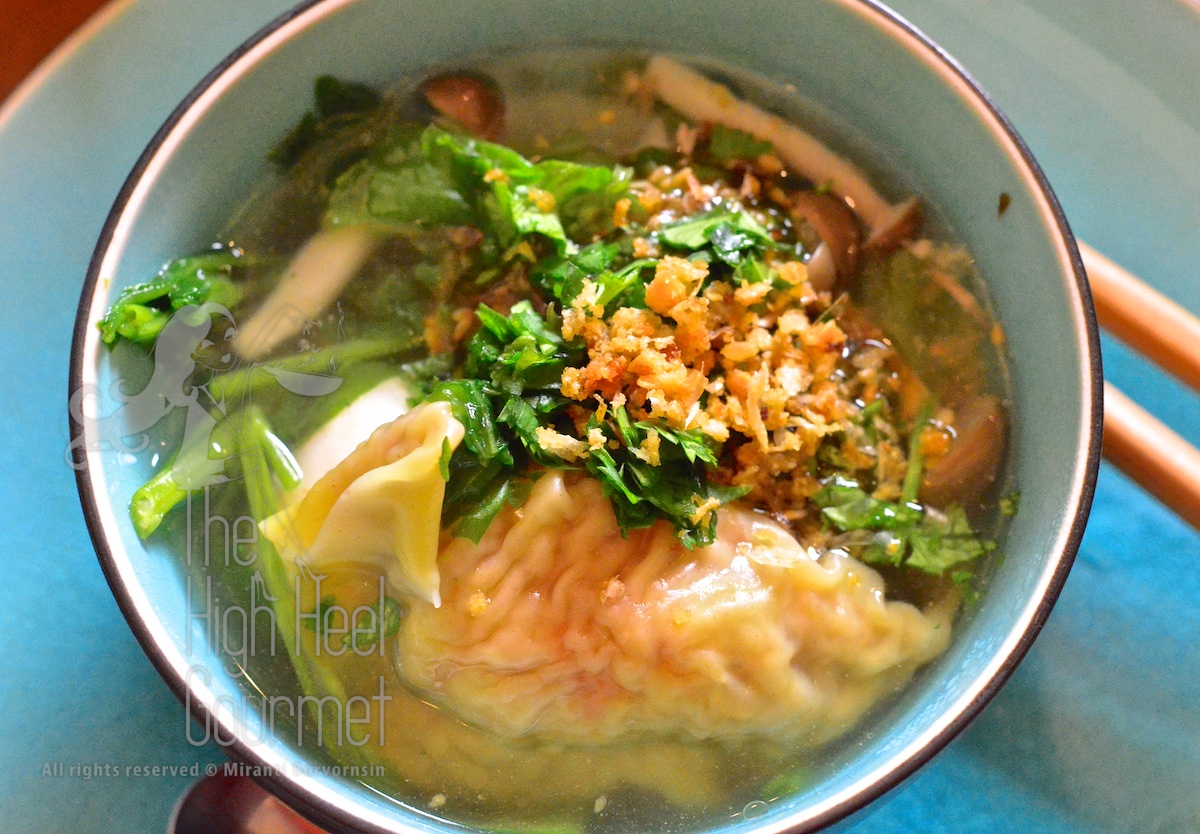
This was my cup. I preferred a smaller, deeper cup so it can store the heat much longer and I only take a few pieces at a time so they don’t get cold before I eat them. You can take the girl out of Asia but can’t take the Asian out of the girl.
* The original chili sauce is made by “Sriraja Panich”, in the Sri- Racha district, Chonburi province of Thailand. Huy Fong Foods version wasn’t made the same way. The taste of REAL Sriracha sauce is a balancing blend between the heat, the sour and the sweet, which is lacking in the Huy Fong brand. I also don’t like the thick texture of the Huy Fong brand either. I prefer it more pourable, like the original. Huy Fong brand chili sauce just feels like a cheap imitation to me compared to the original Sriracha. It is so sour I might use it in place of vinegar instead of chili sauce, or better yet, don’t use it at all. But I just grew up with the original sauce, you know. If your experience with the hot sauce is the lone chicken brand, you might think it’s good. I just don’t.

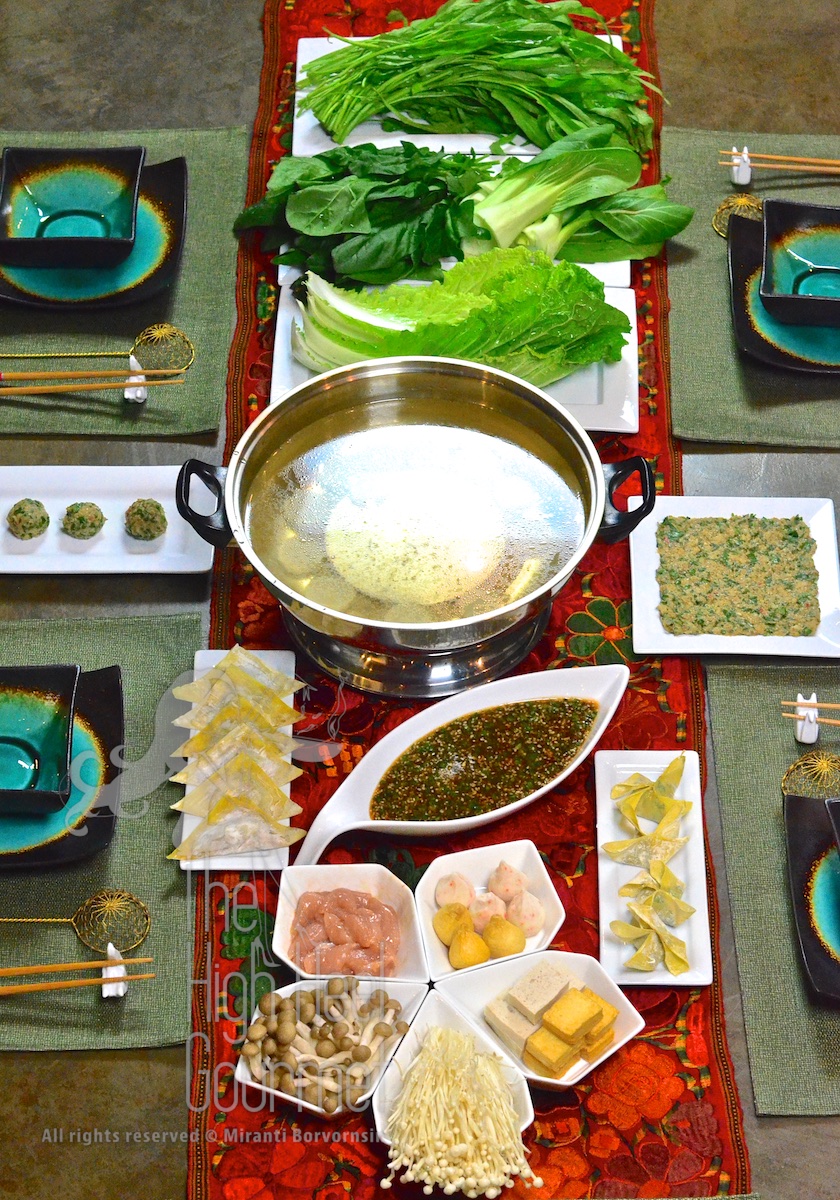
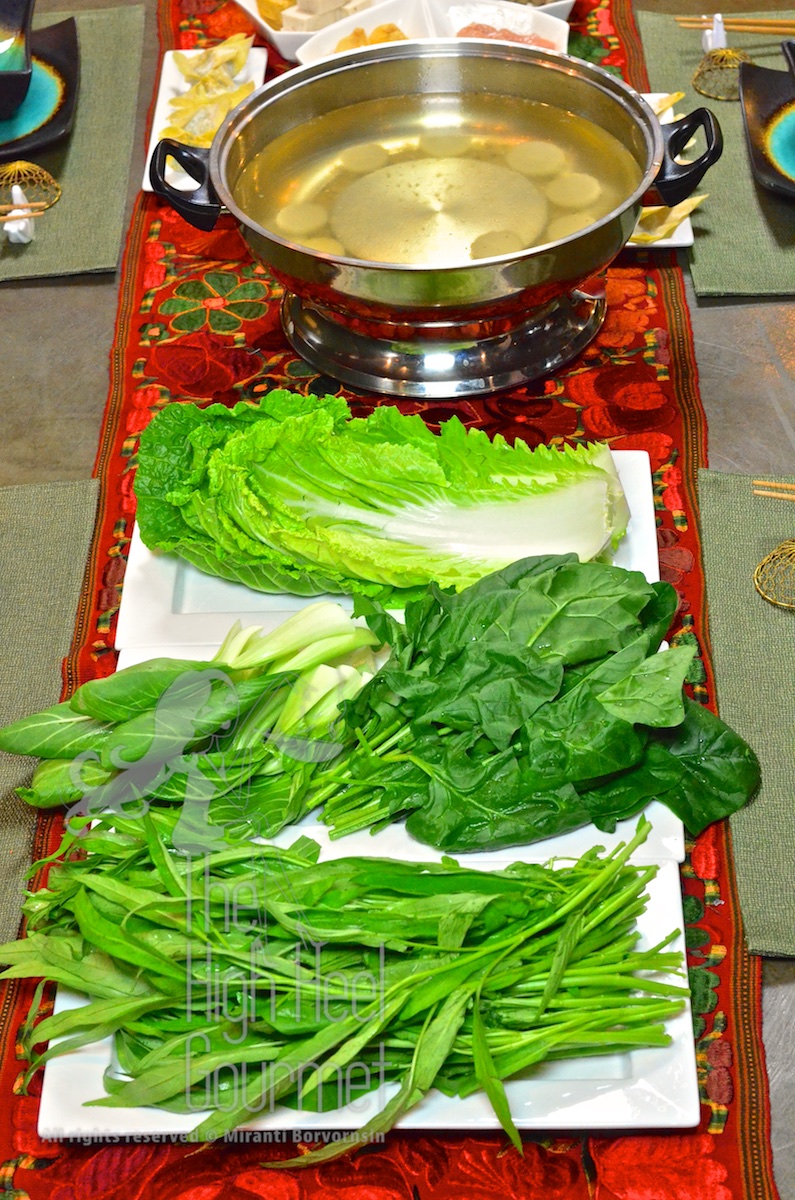
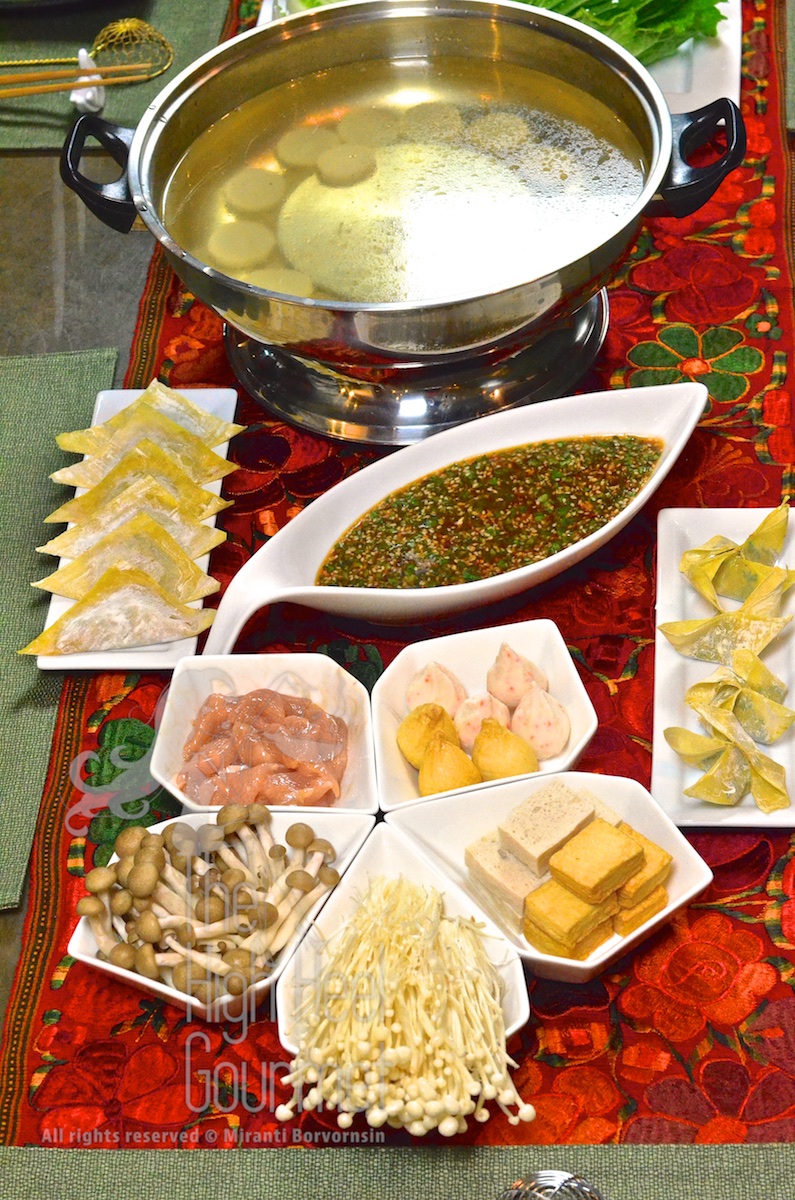
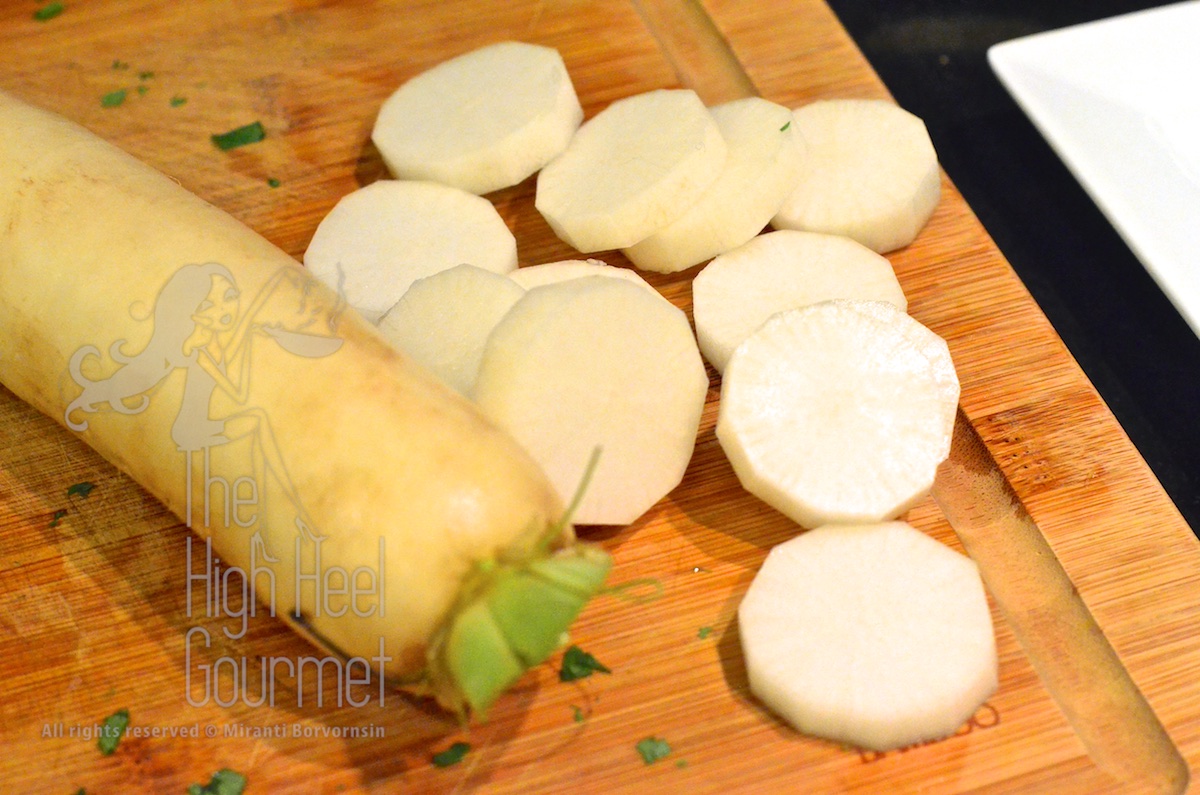
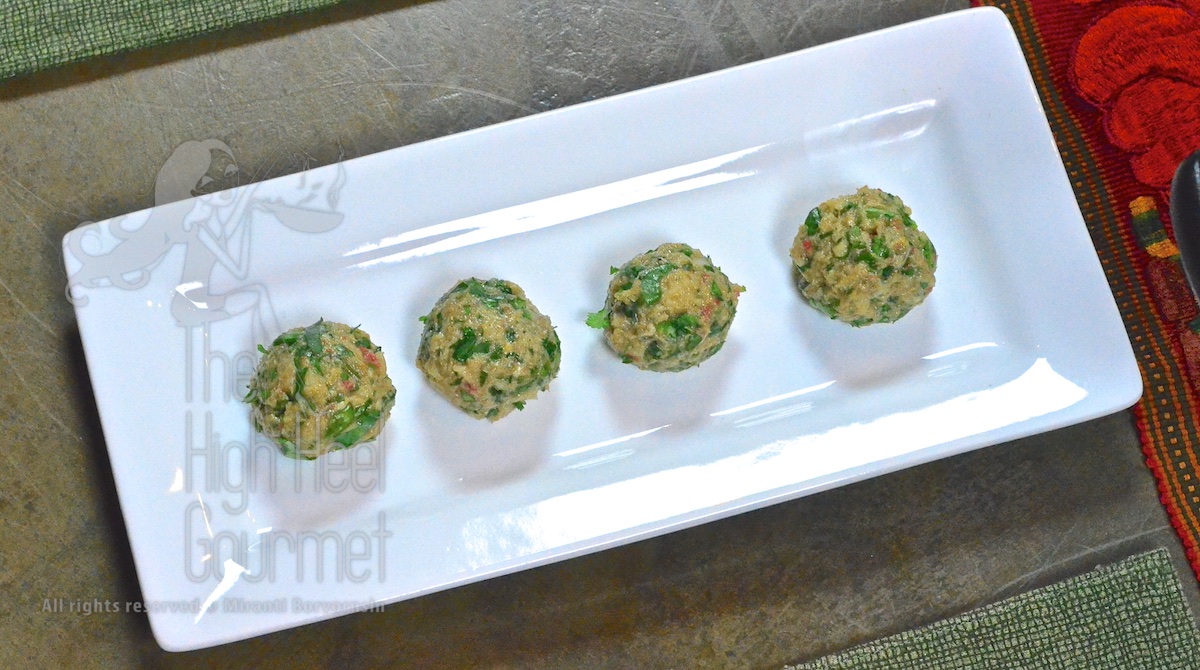
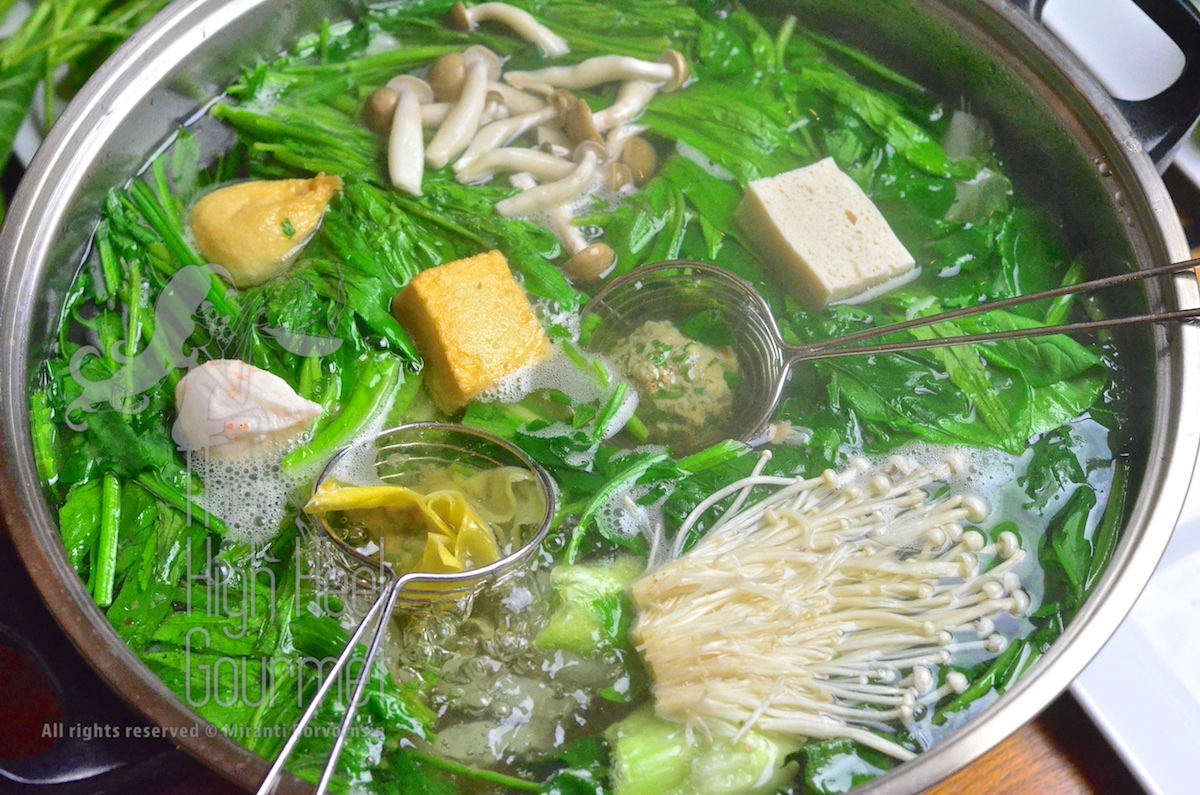
G’day! Looks deliciously healthy, true!
Happy New Year and hope it is a good one for your family, your blog and you!
Cheers! Joanne
Happy New Year to you too Joanne…Thanks!
I LOVE hot pot! and have had much practice since I was a child in getting the best bits from the pot! Thanks for the stories and happy new year!
Happy New Year to you too!
I’m glad you have the skills because if you don’t and are invited to our hot pot dinner, you might be starving. We’re the pro on stealing and pretending that it wasn’t a stolen properties now.
By putting our not so cooked piece back in the sieve to replace the stolen piece. We really fooled the “rookie” completely….my American friend was busy talking and at the end decided to increasing the heat of the pot for this reason “My piece does’t seem to be cooked. It’s been a while. I think the heat must be too low.”…muahhahahaha…we have to give each other the look that said “shiiiiiit…someone give this talkative naive friend a piece of something cooked, please!…The heat is perfect right now”….
A beautifully set out steamboat and what a fun family story!! I first experienced the same in Japan many moons ago [live Down Under] . . . perhaps the first time I ate the now everywhere common tofu squares and shiitake mushrooms . . . it may not be as ‘fashianble in Oz now, but it still makes for relatively easy and very fun entertaining!!
I hope it is fashionable soon. I’m waiting for it to be very fashionable in LA too. It’s available but still too far from my home.
It’s so much fun to do it as a family.
We eat at a great hot pot place in Virginia. I always thought it was very American to steal someone’s food when they’re not looking. Nice to learn we are being authentic!
hahahaha…Yes, you are. I think for the hot pot style or Korean BBQ style cooking, you couldn’t help stealing other people food, right. We used to have this excuse “What…how can you said it yours? If it was really yours, it would be in your bowl or our tummy by now!”…lol…
Beautiful dish, photos and post, as always Miranti. I love a good hot pot and this looks wonderful.
Thanks
Great post as usual 🙂 I’ve had hot pot’s all over the world, in many different countries and continents. Yours is as good looking as any of them and I am sure it’s taste is also up there.:-)
Thanks Hans.
I taste only a handful of different hot pot but I will make a mission to try more. There are some New Chinatown about 20 miles from my house and my friends told me there are many different kind of hot pot in that area.
What a fantastic post Miranti. I appreciate the huge effort that went into this. It must have been a very special celebration.
Thanks Conor.
lol…it’s actually not so difficult to make compare to the whole spread of Thai feast so I made them often especially in winter (warm the house with the steam and also warm out stomach too), until it no longer special but we love them anyway.
Hot pot is tops! In Singapore, it is common to have it for the Chinese New Year’s Eve family reunion dinner, so I see some parallels there. As for deep and shallow bowls, I give my kids their soup in shallow bowls for the same reason your husband uses them. May your 2014 be filled with happiness and good health, Miranti.
Wow, good to know that. I have a friend living in Singapore but she always come back to Thailand during the New Years (tradition) so, I never know what people do in Singapore during that time.
Do they use the same sauce I made or different?
Happy New Year to you too 🙂
BTW I will be back in Sydney again in August and I might book your tour. As soon as I solidify my plan and know which day I will be free, I will contact you.
Reblogged this on The ObamaCrat™.
Very elaborate and beautiful. I wish I was there to partake in the feast!
Thanks!…You can make the feast in your home easily 🙂
Whoa. Gorgeous presentation. Happy New Year!
Happy New Year to you too 🙂 Thanks
Happy New Year Miranti! May this coming year bless you with more joy 😀
Thanks Sam…same to you.
😀
I have just had breakfast, but reading this I’m hungry for Thai food. To be honest I am always hungry for Thai food. I miss it so much!
Well…you can eat all day long. As long as you eat small portion (so you save the space for the next meal) 😉
What a wonderful time it must have been, it all sounds like so much fun! They must be incredible memories for you. And that soup! Oh my, looks fabulous! I just might have to try that one day. Happy New Year! 🙂
It more for the gifts back in the day but I missed it for the company now. Happy New Year to you.
What a nice family story. The food looked good, too.
Thanks…It is a true family feast that is so light. I never really full for more than three hours. 🙂